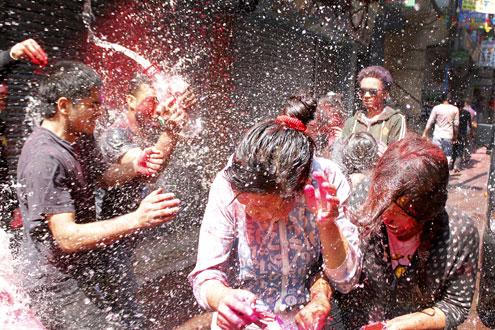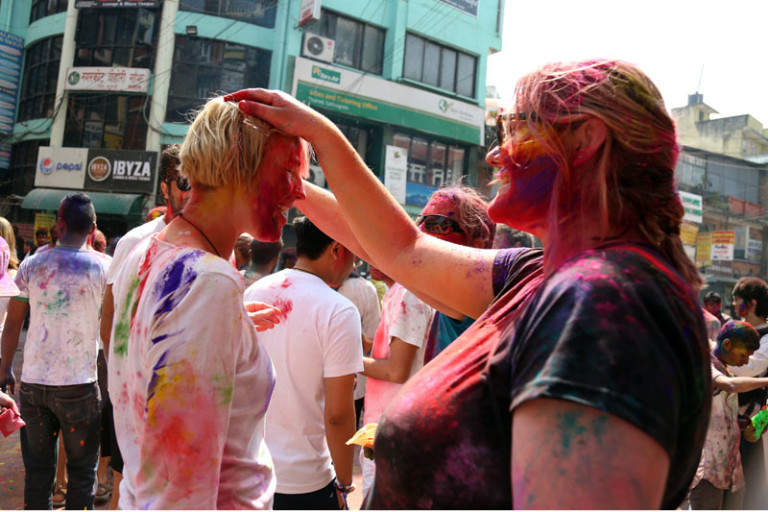
Kathmandu, March 11, 2017: Holi began officially on March 5 (Falgun Shukla Astami) with the installation of a wooden pole called Chir at Basantapur. Celebrated on the day of Falgun Shukla Purnima every year (on March 12 in the Capital this year), Holi has many essences associated with it — it is more than just the Festival of Colours. From merrymaking to carrying forward the culture while understanding the legends behind its celebrations, this festival is loved by many. And thanks to the recent change in people’s ruthless behaviour (of attacking strangers, especially women with lolas), the celebration seems to be going in the right direction. Yet people still seem to lack ample knowledge behind its celebration, and they want more information on it.
A safer atmosphere
A few years ago, Holi meant terror for women. As early as a month before the festival, people would start attacking women and with water-filled balloons and plastics (popular as lola). It would practically be impossible to go out of one’s home a few days before Holi as people would hurl lolas targeting women, from anywhere — windows, terraces, roadsides, public vehicles and so on.
“People throwing lolas used to remind us about the festival’s arrival in the past,” recalled Priyanka Kamatad, a student of Hotel Management, residing in Jadibuti.
“People used to target our private areas with the water-filled balloons,” Mingma Sherpa, a Bachelor’s level student added.
Thankfully, the situation has changed for the better. “These days it is safe to walk around,” Sherpa shared.
Implementation of strict legal provisions over the last few years — that punishes those throwing water and lolas at passers-by — is one of the reasons for people’s change in behaviour.
“It is against the law to hurl water-filled balloons at pedestrians, splash water and smear colours against anyone’s will. If someone is found misbehaving under the pretext of celebrating Holi, s/he will be arrested and be charged under public offence depending upon the gravity of the crime,” warned Bam Bahadur Bhandari, Acting Commissioner and DIG at Metropolitan Police Range, Ranipokhari.

Legends don’t talk lola
Like most Hindu festivals, Holi too has several myths associated with it. The most famous one is the legend of Holika. It is said the word ‘Holi’ is derived from the demoness Holika, sister of the demon king Hiranyakashypu. He disliked Lord Vishnu, yet his son Prahlad was a great devotee of the deity. The father wanted to punish his son and asked his sister’s help. Holika, who was immune to any damages from fire (she had been blessed with the special power), carried the boy and jumped into a fire. But Holika burnt to death and Prahlad was saved. Holi is believed to be celebrated to mark the death of evil Holika signifying triumph of good over evil.
Then there is a lesser known myth from Mahabharata — Lord Krishna informs Yudhisthir about how the festival came into existence in the scripture.
Prof Dr Som Prasad Khatiwada, culture and tourism expert, explained the story, “There was a demoness named Thunda, who used to catch and eat children. And to decrease her power, people used to burn dry wood, leaves among others in the chaubato (intersection of four roads), and chant offensive languages. The celebration of Holi started then. Even these days cow dung, woods et cetera are burnt in Tundikhel during Holi celebrations.”
Again, this myth tells the story of victory of good over evil.
But the way people celebrated it few a years ago — throwing lolas at others — has no connection with both of the stories.
“None of the epics and books tell us about the tradition of attacking others with water-filled balloons or consuming alcohol. Rather, it is a festival that is celebrated with entertainment and dances,” Prof Dr Khatiwada added.
Unaware visitors
Be the lolas or the Chir at Basantapur or any other cultural aspect related to the festival, people seem to lack enough information. Nor they are aware about three others poles in the area — Daak Chowk, Hanuman Dhoka main gate, and Sundari Chowk. “People do not even notice these poles as they are smaller,” stated Rajan Maharjan, President of Yuwa Bishwa Hindu Mahasangh.
You can see idols of Lord Krishna and Gopinis in the Sundari Chowk. “The pole is erected here after bringing the idols of Lord Krishna and his Gopinis to the Chowk.” The bamboo pole with dhwoja pataka (colourful pieces of cloth) has a branch of the Mayal tree on top of it. The pole is then worshipped for eight days during Holi. On the eighth day (on the day of Holi), it is taken down at the auspicious time and burnt. “People fight for the cloth pieces and ashes as they are believed to keep away evil spirits,” Rajan added.
Need to share information
A group of boys were posing and taking pictures under the colourful Chir in Basantapur. But when asked about the significance of the pole, most of them seemed unaware. One of the boys in the group, Bishal Maharjan, narrated how the festival came into existence. Yet he admitted that he lacked detailed information about the rituals, cultural and historical aspects of the festival.
Kamatad, who celebrates the festival every year, shared, “I came to know about this festival through a TV series. One of my relatives also told me about the festival.”
Yet she doesn’t know its legends other than the story of Holika. Her sister Menuka Kamatad too is unaware of its significance — she has seen the pole in Basantpur during Holi, but doesn’t know its meaning.
The sisters claimed they are not indifferent to cultures. “These are our identities and we at least need to know about them,” opined Menuka. Yet they don’t know how to get information about such festivals.
“We don’t even know who to ask about the poles and the festival,” the sisters echoed in a similar voice.

Adarsha Raj Acharya, a plus-two student residing in Naikap, has noticed many visitors (national and international) keen to know about the Chir. And there is no one to explain anything about it. “Had a short information about the Chir been placed here (at the site), it would have been a great help for all,” expressed Acharya.
To explain to others about a certain festival, the person needs to have ample knowledge about it. Teachers, who are there to impart knowledge, should be the source of information for the students. “However, they too are unaware about the festival,” as per Dr Khatiwada.
As a solution to this, he advised, “If we can give them training about the festivals, I hope the children will learn better. People should know about the festivals as they are our identities. Culture and traditions help in the economic and social development of a nation.”
By Sabitri Dhakal






